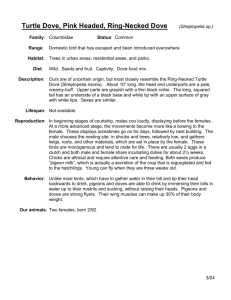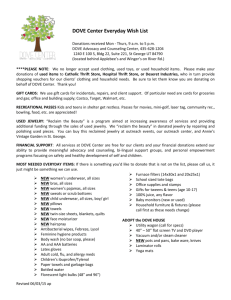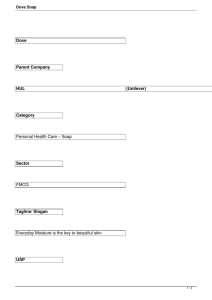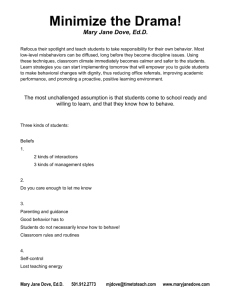Agile Enterprise Cornerstones Knowledge, Values, and Response Ability
advertisement
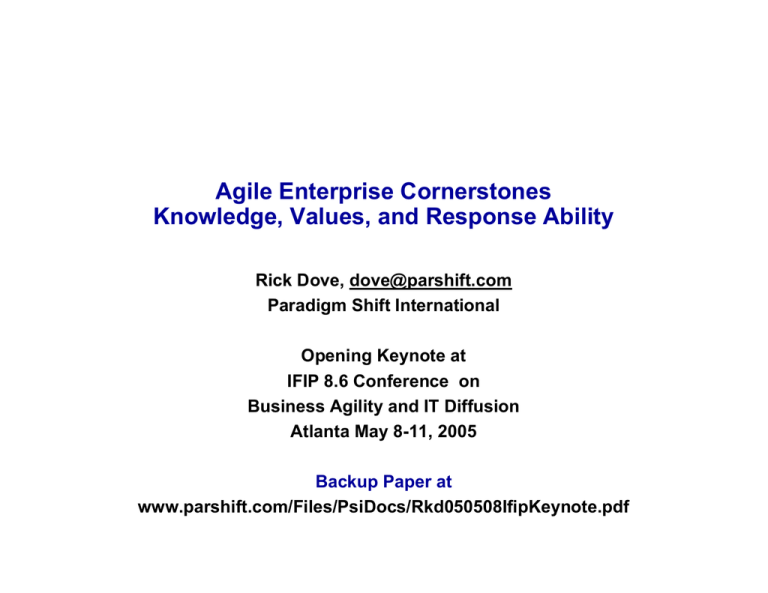
Agile Enterprise Cornerstones Knowledge, Values, and Response Ability Rick Dove, dove@parshift.com Paradigm Shift International Opening Keynote at IFIP 8.6 Conference on Business Agility and IT Diffusion Atlanta May 8-11, 2005 Backup Paper at www.parshift.com/Files/PsiDocs/Rkd050508IfipKeynote.pdf Rick Dove Photo: Brian Zick © 2005 Rick Dove, www.parshift.com, dove@parshift.com - CEO, Paradigm Shift International - Chairman, Agile Security Forum Recent Interim Exec Engagements: - CIO/CSO at Silterra, 1999-2002 - President at ProMetal, 2002-2003 Carnegie Mellon: BSEE UC Berkeley: unfinished PhD in Computer Science 30+ years of start-ups and turnarounds Co-founder of Agile Enterprise concept in '91 at Lehigh Univ. Author: "Response Ability: The Language, Structure, and Culture of Agile Enterprise", Wiley, 2001. New Book: "Value Propositioning: Perception and Misperception in Decision Making", Jan 2005 Lives in Taos, New Mexico, at 8200 feet ......Land of Enchantment. Attributed Copies Permitted The Nature of the Business Environment Unpredictable and Unexpected ©Kurt Jones 2003 © 2005 Rick Dove, www.parshift.com, dove@parshift.com Attributed Copies Permitted How many organizations are older than 100 years? Why is this? (What kills them off) How is this? (What keeps them alive) We are watching the death-slide of General Motors. Why is this happening? Is it reversible? Has an IT mess caused GM's death slide? What role would IT play in GM's recovery? © 2005 Rick Dove, www.parshift.com, dove@parshift.com Attributed Copies Permitted IT is a Key Element of Today's Enterprise Infrastructure Art: Jamcracker Enterprise Infrastructure - Change Management © 2005 Rick Dove, www.parshift.com, dove@parshift.com Attributed Copies Permitted Breaking The Log Jam Where is our research and knowledge base? How to break them. What causes them? How to avoid them? We have no clue. We run up against the social and cultural issues ... and run away. The solution requires systems and engineering science.... If we won't deal with it, who will? © 2005 Rick Dove, www.parshift.com, dove@parshift.com Attributed Copies Permitted Today's Agility Interest – Origin 1991 – SecDef funded project at Lehigh University to identify next manufacturing competitive focus beyond Lean – 13 companies participated full-time in 3-month workshop – Two volume report: 21st Century Manufacturing Enterprise Strategy – Problem and opportunity defined 1992 – Agility Forum founded at Lehigh, funded by a few participants – Purpose: Identify nature of Agile solution – Method: Industry collaborative workshops 1994 – DARPA/NSF fund Agility Forum - $25 Million – Research steering group and agenda established – >250 orgs and >1000 participants in focused workshop groups – Conferences, papers, reference base, tools, reference model 1998 – Mission accomplished, Agility Forum dissolved – Agility pursuit by industry and IT vendors entrenched © 2005 Rick Dove, www.parshift.com, dove@parshift.com Attributed Copies Permitted Defining Systems Agility Observation: Business systems are ill-prepared to respond to changing needs in the unpredictable and uncertain business environment. Accepted definition: "the ability of an organization to thrive in a continuously changing, unpredictable business environment." [various] Systems specific: "The technical subsystems of communication, information, engineering, and manufacturing, will be built from modules such that they can be easily and rapidly reconfigured so as to seize business opportunities. My working definition: Agile systems are ones that can respond to both reactive needs and proactive opportunities - when these are unpredictable, uncertain, and likely to change. Agility is Risk Management: it decreases vulnerability and risk by increasing response options and response predictability © 2005 Rick Dove, www.parshift.com, dove@parshift.com Attributed Copies Permitted Agile-Systems Analysis Research Problem: Technology and markets changing faster than enterprise ability to employ and accommodate Requirements of enterprise-systems are uncertain and unpredictable Flexible systems inadequate when requirements change New approach needed that could extend usefulness/life of systems Note: This research took place at the Agility Forum 1992-1996, and in the author's independent research 1997-1999 © 2005 Rick Dove, www.parshift.com, dove@parshift.com Attributed Copies Permitted Agile-Systems Analysis Research Solution Search: Looked for systems that responded effectively to changing requirements Hypothesized effectively as sufficient response when measured by: 1) response time, 2) response cost, 3) response quality, 4) response scope Hypothesized categories for system-requirements-change as: 1) reactive/demanded and 2) proactive/initiated – with 4 sub-categories each Hypothesized nature of response-enabling design principles Examined 100s of systems of various types (products, processes, procedures, peopled) © 2005 Rick Dove, www.parshift.com, dove@parshift.com Attributed Copies Permitted Agile-Systems Analysis Research Methodology: Collaborative knowledge-development workshops with 10-20 "responsible" people, analyzing 2-3 systems: Realsearch = real people, real problems, real-time Framework driven analysis: metrics(4), change(2x4), principles (10) Evolved the analysis frameworks throughout Captured results in Papers, Benchmark Report, Reference Model, and Book Publications available at www.parshift.com/library.htm and www.parshift.com/publications.htm © 2005 Rick Dove, www.parshift.com, dove@parshift.com Attributed Copies Permitted What Analysis Found – System Requirements Proactive response-needs adequately encompassed by four categories: Creation Improvement Migration Modification Reactive response-needs adequately encompassed by four categories: Correction Variation Expansion Reconfiguration Response effectiveness adequately encompassed by four metrics: Time Cost Quality Scope Note: Adequately means we found no issues or metrics that couldn't fit within the categories, yet found sufficient uniqueness of issues to warrant the variety of categories. © 2005 Rick Dove, www.parshift.com, dove@parshift.com Attributed Copies Permitted What Analysis Found – System Design One general strategy: 1. Reusable modules reconfigurable in a scalable framework. Two general concepts: 1. Scalable Framework 2. Pool of modules Three general capabilities: 1. Assembly of new system configurations from existing modules 2. Augmentation of module pool with new module type or version. 3. Evolution of framework to accommodate new requirements Ten general design principles: 1. Evolving Standards 6. Elastic Capacity 2. Encapsulated Modules 7. Distributed Control/Info 3. Facilitated Plug Compatibility 8. Facilitated Deferred Commitment 4. Facilitated Module Reuse 9. Flat Interaction 5. Module Redundancy/Diversity 10. Self Organization (simple, rare) © 2005 Rick Dove, www.parshift.com, dove@parshift.com Attributed Copies Permitted Agility Fundamentals Enterprise Agility Agility consists of practices and processes for Knowledge Management to have awareness Value Propositioning to select actions • • • • • • • • • Response Ability to enable response in time to innovate and react in systems that have to respond to the unexpected to the anticipated to internal situations to external situations with systems designed for response with systems managed for response ... RA fuels viability and leadership Concepts That Enable Agility © 2005 Rick Dove, www.parshift.com, dove@parshift.com Attributed Copies Permitted Enterprise Agility Agility consists of practices and processes for Knowledge Management to have awareness Value Propositioning to select actions • • • • • • • • • • • • Response Ability to enable response in time to respond effectively establish/change value targets establish/change excellence definitions build new business processes evolve business process framework which standards to adopt seek/abandon/align with new partner seek/abandon/align with new market assemble new configuration prioritize/reprioritize development how to mitigate risks ... VP-ing fuels effective response Concepts That Enable Agility © 2005 Rick Dove, www.parshift.com, dove@parshift.com Attributed Copies Permitted Enterprise Agility Agility consists of practices and processes for Knowledge Management to have awareness • • • • • • • • • • • • Value Propositioning to select actions Response Ability to enable response in time to select actions of what markets (will) need and why of what customers (will) value and why of what partners (will) value and why of what you (will) need and why of your capabilities/competencies/talents of what has to be learned/unlearned of who needs to learn/unlearn something of the risks of the dynamics of reality and how it bites ... KM fuels effective decisions Concepts That Enable Agility © 2005 Rick Dove, www.parshift.com, dove@parshift.com Attributed Copies Permitted Agility consists of practices and processes for Knowledge Management to have awareness Value Propositioning to select actions System Response Architecture Modularity Facilitated Reuse Plug Compatibility principles of Flat Interaction Scalable principles of Evolving Framework Deferred Commitment Redundancy & Diversity Self Organization Distributed Cont & Info molded by language of to take action Reconfigurable principles of Culture of Change Proficiency Change Management with Reusable Response Ability enabling change with Elastic Capacity Change Metrics with domains of Time ProActive Change with domains of Creation Cost Quality Scope Improvement Migration ReActive Change with domains of Correction Variation Expansion Modification Reconfiguration Concepts That Enable Agility © 2005 Rick Dove, www.parshift.com, dove@parshift.com Attributed Copies Permitted Agility consists of practices and processes for Knowledge Management to have awareness Value Propositioning by Decision Champion Response Ability to enable response Decision Maker needs skills of needs skills of Knowledge Knowledge Development Development as Focused Focused as Learning Learning Perception Perception Influencingas Focused Influencing Focused as Educating Educating ROI ROI push-pull Development Development cross links as Business Business as Math Math CommuniCommunication as Focused Focused as cation Clarity Clarity Trust Trust Building as Building as Risk Risk Reduction Reduction Concepts That Enable Agility © 2005 Rick Dove, www.parshift.com, dove@parshift.com Attributed Copies Permitted Agility consists of practices and processes for Knowledge Management providing awareness of Value Propositioning to select actions Response Ability to enable response Creation & Extinction Needs with Dynamic External Data sensors Dynamic Internal Data sensors Data Info Processes Outreach Processes Info Know Processes connecting info to who needs to know for individual/org real-time learning assessing & refining Content Relevance Accuracy Timeliness Concepts That Enable Agility © 2005 Rick Dove, www.parshift.com, dove@parshift.com Attributed Copies Permitted Fundamental Problem Decreasing technology cycles Evolving business models Changing customer expectations Changing market profiles Increasing reliance on increasingly complex technology How do these affect the Enterprise? How do these affect IT requirements? How do these affect the IT mission? © 2005 Rick Dove, www.parshift.com, dove@parshift.com Attributed Copies Permitted Language Change Comes in 2 Flavors... Proactive changes are generally triggered internally by the application of new knowledge to generate new value. Proactive change proficiency: wellspring of leadership and innovative activity. Reactive changes are generally triggered by events which demand a response: problems that must be attended to or fixed, opportunities that must be addressed. Reactive change proficiency: foundation of viability and opportunistic activity. © 2005 Rick Dove, www.parshift.com, dove@parshift.com Attributed Copies Permitted ...and 8 Domains... Reactive Proactive Change Domain Definition Creation (and Elimination) Build new capability (or eliminate some). Improvement Continuous daily incremental upgrade. Migration Foreseen, eventual, and fundamental change. Modification (Add/Subtract Capability) Addition or subtraction of unique capability. Correction Rectify a dysfunction. Variation Real-time operating change within mission. Expansion (and contraction of capacity) Increase or decrease existing capacity. Reconfiguration Change relationships among modules. © 2005 Rick Dove, www.parshift.com, dove@parshift.com Attributed Copies Permitted ...and 4 Metrics Time Cost $ $ $ $ Elapsed Time $ Time Cost Total Cost $ Activity Based Change-Costing Bad 100% Quality 0% On-Time, On-Budget, On-Spec Predictability Quality © 2005 Rick Dove, www.parshift.com, dove@parshift.com Scope Latitude OK Stretch Good Range Mission Boundary OK Stretch Sufficient Economic Range? Scope Attributed Copies Permitted Structure Basic Definitions System Stereo System of Components A group of modules Company of Divisions sharing a common interaction framework and serving a common purpose. Framework Chain of Suppliers A set of standards constraining and enabling the interactions of compatible system components. Practice of Procedures Module A separable system sub-unit with a self-contained capability/purpose/identity, Cell of Workstations and capable of interaction with other components. © 2005 Rick Dove, www.parshift.com, dove@parshift.com Team of People Attributed Copies Permitted Frameworks: Three Types of Construction Toy Systems Glue Chaordic1 Lego Lego Lego Model Chaotic Lego Ordered Lego Erector Set Note: 1 Dee Hock coined the word chaord for organisms, organizations, and systems which harmoniously exhibit characteristics of both order and chaos. The Birth of the Chaordic Century: Out of Control and Into Order, Chaordic Alliance, 1997, www.chaordic.org. © 2005 Rick Dove, www.parshift.com, dove@parshift.com Attributed Copies Permitted Response Able System Principles (RRS Principles) Evolving Standards (Framework) - Frameworks standardize inter-component communication and interaction; define component compatibility; and are monitored/updated to accommodate old, current, and new components. interface Reusable Plug Compatibility Components share defined interaction and standards; and are easily inserted or removed. Facilitated Reuse Components are reusable/replicable; and responsibilities for ready re-use/replication and for management, maintenance, and upgrade of component inventory is specifically designated. Scalable Self-Contained Units (Modules) Components are distinct, separable, loosely-coupled, selfsufficient units cooperating toward a shared common purpose. Redundancy and Diversity Duplicate components provide capacity right-sizing options and fail-soft tolerance; diversity among similar components employing different methods is exploited. Elastic Capacity Component populations in response able systems may be increased and decreased widely within the existing framework. Reconfigurable Peer-Peer Interaction Components communicate directly on a peer-to-peer relationship; and parallel rather than sequential relationships are favored. Deferred Commitment Component relationships are transient when possible; decisions and fixed bindings are postponed until immediately necessary; and relationships are scheduled and bound in realtime. © 2005 Rick Dove, www.parshift.com, dove@parshift.com Distributed Control and Information Components are directed by objective rather than method; decisions are made at point of maximum knowledge; information is associated locally, accessible globally, and freely disseminated. Self-Organization Component relationships are self-determined; and component interaction is self-adjusting or negotiated. Attributed Copies Permitted A Look At Silterra Strategy A semiconductor foundry in Malaysia Art: Energy IT © 2005 Rick Dove, www.parshift.com, dove@parshift.com Attributed Copies Permitted Infrastructure Design MyFab Oracle 11i Apps Oracle ERP dB Adexa Planner People Soft Apps My Projects Other Apps Other dBases XML Enterprise Bus A&T = Assembly & Test Plant Fab = Foundry Plant Fab #1 Fab #n A&T #1 A&T #n • = Bus Interface Module (BIM) • = ETL Interface Modules • MyProjects = Web-accessible strategic-project portfolio manager • MyFab = Web-accessible operations transparency www.parshift.com/Files/PsiDocs/Rkd050324CserPaper.pdf © 2005 Rick Dove, www.parshift.com, dove@parshift.com Attributed Copies Permitted Develop Architecture and Design Develop Business Rules and Specs Manage Outsourced Development Conduct Testing and User Training 3-Phases Days 60-90 V V3 …….. 3 91-180 150-180 bsa V2…….. bsa V2 IT V3……..IT V3 Template bsa ssa bsa 60 days 120 days Prog. Mgr ssa Days 0-90 V V2 …….. 2 bsa Proj. Mgr ssa bsa bsa bsa bsa bsa Alpha 181-270 bsa ……..bsa V2 V2 240-270 IT …….. IT V3 V3 Beta Encapsulated ERP Implementation Process - Designed to Accommodate Requirement Evolution www.parshift.com/Files/PsiDocs/Rkd050324CserPaper.pdf © 2005 Rick Dove, www.parshift.com, dove@parshift.com Attributed Copies Permitted Effective Predictability ERP on time, below budget, on spec 3 months functional ERP "best practice" (Phase 1) 3 months later preferred business processes (Phase 2) 3 months later refined business processes (Phase 3) HRM modularized and added below time, on budget, on spec Adexa planner added on time/budget/spec Existing Time and Attendance system modularized and integrated on time/budget/spec © 2005 Rick Dove, www.parshift.com, dove@parshift.com Attributed Copies Permitted Effective Predictability Wish ERP in 12 mos total 75% of license budget $10 Million (5 + 5) Typical Imp 24-36 mos 200-300% $15-25 Million Actual Imp 121,2 75% $9 Million HRM in 6 mos 12-18 mos 5 mos HOW?? Principle-based integration process methodology and management Adherence to methodology (ie, effective management) BSAs utilizing MBW tool to develop and capture business processes BSAs taking responsibility for integrating ERP with users Bus architecture connecting ERP with HRM Experienced outsource to help integrate ERP/CIM2,3 (did it before) Expertise in agile system design and implementation Notes: 1) 12 months = 3 mo concept design and vendor selection + 9 mo implementation, time included infrastructure bus/ETL/BMI implementation, but not shop floor (CIM) integration (+6) 2) New Oracle 11i ERP with typical bugs and lack of documentation of new systems 3) Additional 6 mos due to independent CIM system shake out © 2005 Rick Dove, www.parshift.com, dove@parshift.com Attributed Copies Permitted Employment of principles... Forces consideration of each principle: better design-for-agility Values: increases scope of response options, reduces future cost and time Defines clear framework: integration rules don't change Values: increases predictability of project, reduces current cost and time Defines encapsulated modules: requirements don't change Values: increased predictability of project, increased options for alternatives, reduces current cost and time © 2005 Rick Dove, www.parshift.com, dove@parshift.com Attributed Copies Permitted Note: Relationships flow downward in concept maps unless an arrowhead is present. Agility Silterra's Agile Strategy Concepts consists of Knowledge Management Value Propositioning Response Ability activities are activities are Service Integration Mgmnt apps are Strategy Delivery Mgmnt apps are Customer Satisfaction Mgmnt apps are IT Infrastructure Mgmnt apps are IT Adaptation Mgmnt apps are Talent Relationship Mgmnt apps are Adaptable Systems Mgmnt apps are Security Evolution Mgmnt apps are MyStaff MyProjects MyFab Architecture & MyBus & MyETL Culture & Process Outsource Support Culture & Training Principles & New Vision with objectives defined by with proactive domains of Modification Migration Improvement Creation Response Situation Analysis resolved with architecture that is with reactive domains of Correction Reusable Reconfigurable Scalable Variation Expansion Reconfiguration based on principles of Redundancy/ Diversity Deferred Commitment Facilitated Reuse Plug Compatibility SelfContained Units Evolvable Framework Elastic Capacity www.parshift.com/Files/PsiDocs/Rkd050324CserPaper.pdf Self Organization Distributed Ctrl & Info Peer-Peer Interaction Value Propositioning Reality and Responsibility © 2005 Rick Dove, www.parshift.com, dove@parshift.com Attributed Copies Permitted Individual Decision Logic Decision Makers hear promised benefits with a bit of healthy skepticism. Kaheman & Tvarsky: Prospect Theory Individual Decision Behavior reflects valuation as: In the information technology arena, with a good deal of skepticism. They associate a with probability, that a benefit Psychological will deliver as Bias looks like promised. Non-Linear Relative unless shaped as Ruiness Outcome "S" Curve Value Over Under Over Low Prob High Prob Certainty [interpretation of Prospect Theory] Weighted Weighted Weighted Under Valued Increases to Losses Loom Larger Knowledge Dependent by if DM has Elimination Hopes and Expectations sets neutral point of Perception as Loss or Gain if Chunking Probabilities Not Significant High Knowledge Low Knowledge perceptions of effect is Steeper Negative Values Simplified which biases Status Quo shaped by They know Initial Loss Gain Gains/Losses from Dominate experience effect is that Diminishing Incremental honest Values claims assume ideal conditions of implementation, results in results in results in results in transfer, and acceptance. Formulation Dependent Low Probability Gain results in results in Loss Averse Behavior Risk Seeking Behavior High Probability Loss results in Risk Averse Behavior High Probability Gain Low Probability Loss results in Simplification results in Under Weighted Prob results in Over Weighted Prob Details at: www.parshift.com/ValueProp Probability (Prob) is the subjective likelihood, assumed by a Decision Maker, that a proposed benefit will deliver as promised. © 2005 Rick Dove, www.parshift.com, dove@parshift.com Attributed Copies Permitted Group Decision Logic Group Decision Behavior involves The Decision Maker "...looks for a course of action that is satisfactory, or 'good enough'....Because Objective Perception Setting Creation administrators satisfice ... they can includes interpreting make their decisions with Value Propositions relatively simple from Influenced by rules of thumb Attention Focus Candidate that do not Training and Solutions Experience make Simple selected by Patterns impossible Decision Search Psychology Process demands Unresolved Conflict determined by upon their Amount of Org Slack capacity forObjective thought. Performance Targets List Cyert & March: Behavioral Theory of the Firm Simon: Administrative Behavior Choice based on Standard Rules based on Past Experience [Herb Simon] © 2005 Rick Dove, www.parshift.com, dove@parshift.com Past Org Slack Mitigating Conflict Who's Searching Simplification may based on Similarity based on to Current lead to error, but there is Solution Past Objectives no realistic alternative Past in the Performface of the limits on human DM's PerformGroup ance ance of Members Objectives knowledge andOthers reasoning." avoids uncertainty by Acceptable Level Rules by Sequential Attention Short Term View Negotiated Predictability results in results in results in results in Lowest Commonality Postponing Some Objectives Contract Terms "Satisficing" Valuation Problem Perception Details at: www.parshift.com/ValueProp Attributed Copies Permitted Misperception Logic Plous: Behavioral Psychology of Decision Making Recreating from memory what was witnessed at an auto accident is not unlike trying to remember what was shown in a project presentation, or what was read in a written proposal. Information is Context Dependence selectively may use filtered and Contrast Primacy Recency interpreted by the observer Effect Effect Effect in the process of becoming making meaning meaning memory and First perception. Last Comparison Perception Perception Thewith end result is will a be setSpecific of perceptions Dominate Reference Perception that are both incomplete and different than the original information. Misperception is caused by Perception Creation Memory Bias determined by determined by Selective Perception Halo Effect making Associated Perceptions conform to [paraphrasing Plous] © 2005 Rick Dove, www.parshift.com, dove@parshift.com conforms to Cognitive Dissonance Hindsight Bias forces believing Consistency Past Event Hopes with Self Image from Partial Memory was Expectations Reconstruction of Event Predictable filled in with by changing Old Perceptions Other Information Inferred Details drawn from results in Biased Knowledge Details at: www.parshift.com/ValueProp Associated Memories Attributed Copies Permitted Perception Formation Logic Perception Formation "The most important single factor influencing learning is what the learner already knows. Ascertain this and teach him accordingly." [David Ausebel] David Ausebel, Meaningful Learning Joseph Novak, Concept Maps is Learning which creates with dimensions of Knowledge which appears to be Relevancy Source has scale spanning has scale spanning Rote Close Prior Knowledge Meaningful Commitment To Learn © 2005 Rick Dove, www.parshift.com, dove@parshift.com with principles of requires learner with Interest in Material Internal Self Discovery Hierarchy as New Info Subsumed Under Old External Presentation reflecting Structured Concepts that can be modeled as Concept Maps consisting of Progressive Differentiation Integrative Reconciliation Concepts as as connected by Increasing Linkage & Refinement Cross Links & Fixed Links Relationships Details at: www.parshift.com/ValueProp Attributed Copies Permitted Reality Factors Agile Security Strategy An Instructive Model For Developing an Agile-Solution Strategy (from The Agile Security Forum) See: www.AgileSecurityForum.com © 2005 Rick Dove, www.parshift.com, dove@parshift.com Attributed Copies Permitted Business Strategy Elements Policy: Goals, and principles governing how goals may be attained. Procedure: Prescribed method for satisfying policy. Practice: Implementation that carries out procedure. Security is a Business Process distributed and co-mingled with other business processes © 2005 Rick Dove, www.parshift.com, dove@parshift.com Attributed Copies Permitted Security Strategy eXcellence? Vulnerability Threat Risk The Facts: – Increasing points and modes of attack – Increasing attackers and incidents – Increasing value available for compromise The Value Proposition Foundation: Time stolen by security measures is increasing Money invested in security measures is increasing Effectiveness and life-cycle of security measures are decreasing © 2005 Rick Dove, www.parshift.com, dove@parshift.com Attributed Copies Permitted Security's Seven Ignorances of Reality 1. Human Behavior – Human error, whimsy, expediency, arrogance, ... 2. Organizational Behavior – Survival rules rule, nobody's in control, ... 3. Technology Pace – Accelerating vulnerability-introductions, ... 4. System Complexity – Incomprehensible, unintended consequences, ... 5. Globalization – Partners with different ethics, values, infrastructures, ... 6. Agile Enterprise – Outsourcing, on-demand, webservices, transparency, ... 7. Agile Attackers – Distributed, collaborative, self organizing, proactive, ... For 50 years of IT-progress, management policy/procedure/practice has followed behind ... patching potholes. © 2005 Rick Dove, www.parshift.com, dove@parshift.com Attributed Copies Permitted SP SP Penalties Regulation Org Beh av Attacker Behavior SP ior Security Process Laws Litigation Human Behav ior Maintaining Systems in Unstable States Takes Constant Energy Input Se Pr cu oc rit es y s Rules Threats Reality Landscape Expecting or enforcing ideal and repetitive behavior ignores reality... and is not a substitute for Strategy © 2005 Rick Dove, www.parshift.com, dove@parshift.com Attributed Copies Permitted Strategy Requires Understanding A rational view of the problem: Reality bites – what is its nature? The problem is bigger than technology – what is its nature? The situation is in constant flux – what is its nature? A rational view of the solution: You are compromised – now what? Situation in constant flux – what is proactive response-ability? eXcellence – what is its nature? © 2005 Rick Dove, www.parshift.com, dove@parshift.com Attributed Copies Permitted Knowledge Frameworks for Situation Analysis Analysis Frmwks Agile Security Forum Pathfinder Initiative www/parshift.com/AgileSecurityForum include Reality Issues eXcellence Focus arising from dealing with with reactive domains of with proactive domains of Situation Analysis Technology Pace Systems Complexity Policy Correction Creation Agile Enterprise Globalization Procedure Variation Improvement Human Behavior Org Behavior Practice Expansion Migration Now/Soon Competitors (Perhaps More) Reconfiguration Modification www.AgileSecurityForum.com/Docs/AsfPaperSixFrameworks.pdf The Bite © 2005 Rick Dove, www.parshift.com, dove@parshift.com Technology+++ Flux Attributed Copies Permitted Knowledge Frameworks for Strategy Solutions Solution Frmwks Agile Security Forum Pathfinder Initiative www/parshift.com/AgileSecurityForum include Agile Principles eXcellence Principles of dealing with with proactive domains of with reactive domains of Reality Objectives Self Contained Units Evolvable Framework Requisite Variety Vulnerability Anticipation Detection Plug Compatibility Elastic Capacity Parsimony Prudence Containment Facilitated Reuse Self Organization Harmony Transformation Mitigation Deferred Commitment Distributed Ctrl & Info Threat Anticipation Assessment Redundancy & Diversity Peer-Peer Interaction Migration Recovery Accountability Accountability (proactive) Flux eXcellence (reactive) Compromised www.AgileSecurityForum.com/Docs/AsfPaperSixFrameworks.pdf © 2005 Rick Dove, www.parshift.com, dove@parshift.com Attributed Copies Permitted Suggested eXcellence Principles Requisite Variety Ashby's Law: "The larger the variety of actions available to a control system, the larger the variety of perturbations it is able to compensate....variety must match variety." Any effective system must be as agile as its environmental forces. Reality-compatible (rational) policy, procedure, and practice. Functional Quality. Parsimony Occam's Razor: Given a choice between two ... choose the simplest. Unintended consequences are the result of complexity. Humans can only deal with 5-9 items simultaneously. Bounded rationality (Herb Simon). Reduces perceived Risk. Harmony (.... Delight?) Perception: non-negative impact on personal productivity and goal priorities. Perception: non-negative impact on org's productivity and goal priorities. Rationalized with natural human and org behavior. Engenders feelings of user Trust and Respect. Aesthetic Quality. © 2005 Rick Dove, www.parshift.com, dove@parshift.com Attributed Copies Permitted A Framework with Requisite Variety, Parsimony, and Harmony BANTAM BOOKS The Three Laws of Robotics (Isaac Azimov) 1) A robot may not injure a human being or, through inaction, allow a human being to come to harm. 2) A robot must obey orders given it by human beings except where such orders would conflict with the First Law. 3) A robot must protect its own existence as long as such protection does not conflict with the First or Second Law. © 2005 Rick Dove, www.parshift.com, dove@parshift.com Attributed Copies Permitted Unintended Consequences Understand the Dynamics of the Environment © 2005 Rick Dove, www.parshift.com, dove@parshift.com Attributed Copies Permitted Art: Napster Agile IT is Enterprise Risk Management that Reduces Risk by Providing Options with Predictable Response in an Unpredictable Environment © 2005 Rick Dove, www.parshift.com, dove@parshift.com Attributed Copies Permitted
